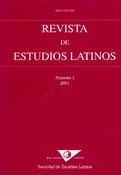Siem, sies, siet in the verses of Plautus and Terence: some remarks on prosody, metrics and stylistic
DOI:
https://doi.org/10.23808/rel.v3i0.87947Keywords:
archaism; subjunctive; metrics; prosodyAbstract
Usually, in Latin, forms of the present subjunctive mood siem, sies, siet... are considered as archaisms in Plautus and Terence’s plays, and for that reason –and because of their prosodic nature–, we generally consider that they must appear at tne end of the verse in the iambo-trochaic system. Things however are a bit more complicated than this. Indeed, when these forms appear, we may note that they don’t systematically take place at the end of verses or at the end of hemistiches: for metrical, stylistic or syntactic reasons, they may be used in places that most of the time coincide with pauses of minor importance. After that, we may show how these forms are included in syntactic structures that create conditions of a formulaic style, sustained by the metrical organisation of the verse and by the verbal commutations. Finally, in this way, we’ll notice some differences between Plautus and Terence regarding linguistics, prosody and metrics.
Downloads
Downloads
Published
How to Cite
Issue
Section
License
Copyright (c) 2003 Revista de Estudios Latinos

This work is licensed under a Creative Commons Attribution-NonCommercial-NoDerivatives 4.0 International License.
The originals published in the printed and electronic editions of this journal are the property of the Revista de Estudios Latinos and can be circulated as long as the original source and authorship is made clear in any reproduction, full or partial, of the same, and as long as this is not done for commercial purposes.






